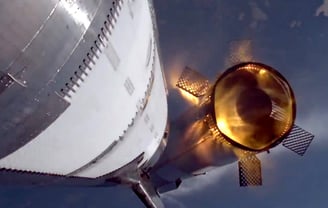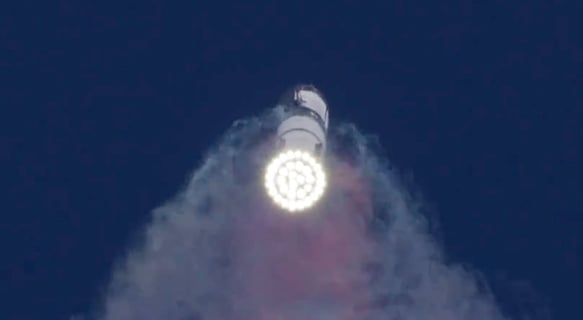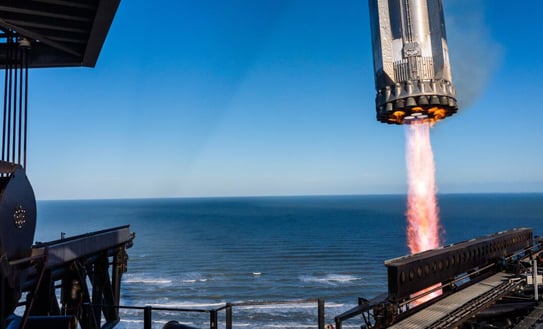Starship successfully burned on the seventh attempt, and debris rained from space | Tracer Tecz
This screenshot captured from SpaceX’s live stream of Starship Flight 7 features a look outside of Starship as seen with a rear-facing camera mounted on the spacecraft. The Super Heavy booster stage is pictured as soon as it successfully separated from Starship, with four grid fins deployed.
1/18/20259 min read


Elon Musk’s SpaceX shot up an advanced model of a giant Starship spacecraft on Thursday from South Texas, but the flight was cut short and the spacecraft plunged back to the launch site, all in a shamelessly short 8 minutes and 44 seconds. Even during the SpaceX’s webcast of officials analysing the launch, they were somewhat uncertain of the fate of the test flight. However, within minutes, locals and tourists in the Turks and Caicos Islands, Haiti, Dominican Republic, and Puerto Rico uploaded footage of what appeared to shower the sky, Within the forecast path of Starship, with debris falling through mid-air.
The videos further solidified that yes Starship—the rocket’s upper stage—disassembled in space or had a ‘rapid unscheduled disassembly,’ said SpaceX. This occurred far from the intended flight path that would have seen the spacecraft travel half way around the world to land in the Indian Ocean after one hour and forty minutes of flight. There were no people or satellites aboard the rocket Thursday.
Flight diversions
The test flight began with the liftoff of the 404-foot-tall (123.1-meter) Super Heavy booster and Starship upper stage from the Texas Gulf Coast at 4:37 pm CST (5:37 pm EST; 22:37 UTC). The world’s biggest and highest capacity launcher lifted off the launch tower with greater than double the thrust of the NASA’s Apollo period Saturn-V. Travelling east, all 33 of the methane burning Raptor booster engines burnt for over 155 seconds and sent Starship towards the Karman line.
As expected, the booster engines terminated, and satellites later fired an additional six Raptor engines on Starship’s upper stage. The Super Heavy booster detached from the rocket in order to perform the back to the launch site. With only 24 seconds less than 6 minutes and 53 seconds since the launch, the booster came back to the launch pad to meet another catch by the tower’s two mechanical arms for the second time after SpaceX in October.
The upper stage seemed to function normally until on SpaceX’s webcast, telemetry showed that one of the ships six engines had failed more than seven minutes into the flight. The display then went on to reveal even more engines going down and then the data flow stopped. On Thursday evening, SpaceX updated the event that happened during the mission on their site stating that, the ground teams lost control of the spacecraft about eight and a half minutes after liftoff. In the detailed data available during space X’s live video stream it was identified that the vehicle was at 13,246mph/21,317km/hr with an altitude of about 91miles/146kilometres at the time.
‘Early assessment suggests a fire started in the AFT part of the tow ship progressing to a RS Disassembly with burn and impact in the defined BAT HAZ cone into the Atlantic Ocean,’ SpaceX officials stated in the update. It forced air traffic controllers to either reroute or redirect commercial aircraft that were operating over the Caribbean and the Atlantic, the Federal Aviation Administration said.
Controllers can declare a debris response area in the case of an uncontrolled spacecraft coming apart with debris outside of those areas, where the FAA warns pilots in advance of entering them to expect space debris. Activating a Debris Response Area “enables the FAA to safely lead those Aircraft out of the area and to refrain further Aircraft from entering that area,” the statement stated. This is what the FAA did Thursday evening They consisted of a large bevy of requests like the one below.
Some commercial air traffic was disrupted for more than an hour due to air traffic controllers’ temporary closure of the airspace between Turks and Caicos Islands, the Dominican Republic and Puerto Rico. Portal that track flight revealed the severity of the effects on the airborne traffic. Miami International Airport and the Fort Lauderdale International Airport through which most Caribbean-bound planes pass said they experienced short flight delays because of a “rocket launch anomaly”, the FAA website said.
Ars taped the live audio of the air traffic control in San Juan, Puerto Rico, as they warned pilots of the restricted airspace. Many critics have also asked how long they believe this hold is going to be? ‘We don’t have a lot of gas to play with,’ one pilot asked air traffic control. It will be better if we are on the ground as early as possible.” Some minutes later the airspace was again cleared and the flights either proceeded to their intended destinations, or proceeded to others.
A number of videos filmed by residents and tourists in the Turks and Caicos suggest(True)that fiery debris fragments of the meteor moving across the sky, cross almost vertically upwards. Some of the people speaking in the videos had no idea what they were witnessing, but astronomers and enthusiasts on social media knew right where the light show was coming from.
From X, the founder and CEO of SpaceX Elon Musk said that the first signs from data pointed to a propellant leak in a cavity above Starship’s engine firewall. It was large to begin to build a pressure of gas beyond the capabilities of the ship’s venting system. “Beyond just make sure there are no leaks, we will add fire suppression to that volume and likely more venting area,” Musk wrote. “Up to now there’s been no indication to take next launch beyond next month.
” As SpaceX entered 2025, executives expected that the company would conduct up to 25 Starship test flights this year to experiment with various designs, try to reuse a Starship back from orbit, and demonstrate orbital refueling, important to NASA and SpaceX’s plans to land humans on the Moon in the latter half of this decade. SpaceX developed starship to be fully reusable that CAN transport more than 100 metric ton to low earth orbit. Subsequent versions of the ship will be designed for traveling to the Moon and Mars. NASA has contracted SpaceX for two rockets for $2.9 billion to build a derivative of Starship as a human rated lander for Artemis lunar program, while Musk sees Starship at the core of his mission to set up a city on the red planet.
NASA’s public service schedule currently plans for the crew to touch down at the lunar south pole in 2027 utilizing SpaceX’s Starship as well as the SLS’s government-operated Orion crew capsule. Combined, the vehicles will ferry the astronauts through the lunar excursion from Earth, to the Moon’s orbit and then from the lunar surface back into space, and then return to Earth.
Nonetheless, this schedule presupposes the preparedness of Starship to host humans, new lunar spacesuits, the status of the SLS rocket and Orion spacecraft; all of which have experienced multiple set backs. Future Trump administration is likely to reconsider fundamental design of Artemis program to decide if and how NASA can bring back the humans into the lunar orbit faster and cheaper. Of course, SpaceX’s Starship and other Institutional launch vehicle services might establish a far more pronounced role.
If SpaceX is able to bring Starship airborne next month, the company might be able to save these goals for the program this year. SpaceX is not lacking for hardware ready or close to it at any given time. A number of Starships and Super Heavy boosters are in various stages of readiness currently stored at the company’s Starbase launch site in Texas.
Schedules give way in the launch business, and the FAA could pause Starship operation until SpaceX finishes a mishap investigation. The federal regulator is officials in charge of the welfare of the public that involves itself in commercial space launches. Late Thursday, a spokesman said that the FAA is looking into the Starship anomaly and will comment once more is known about it.
During the few hours following the Thursday test flight, Musk used the company’s social media account to share and comment on several videos depicting fragments of the Starship returning to earth. SpaceX has always encouraged failure if it comes along with knowing, the organizational culture of SpaceX embraces the idea of paced evolution with designs mainly: build test break fix.
It marked the beginning of what is now called Version 2 or Block 2, which distinguishes it from the mass production Starship: 30ft tall, 6 Raptor engines, new avionics, greater propellant tanks, new feed tubes for Methane and liquid oxygen. Neither of the SpaceX officials commented on whether any of these revisions might have led to the issue witnessed during Thursday’s launch. As we mentioned earlier, SpaceX officials have said over and over again and in rather precise terms how each Starship test flight will go.
They regularly call the rocket experimental, and the goals of the initial demo missions of the rocket are explicitly explicitly stated to be gathering data on the performance of the vehicle. A comparison of the best and worst: However, the fact that Thursday’s test flight ended was not the best result for SpaceX; it was unsuccessful. This was the seventh test flight of the firm’s massive rocket and the first time that the booster’s smaller companion, Starship, had not been able to fully launch. Until now, SpaceX is steadily going ahead, and every next Starship flight is accomplishing more features than the previous one.
In the first flight in April 2023, the rocket control was lost a little over 120 seconds after the launch and the thrust produced by the booster’s 33 engines not only damaged the launch pad but also consumed its concrete base. On Flight 2, it performed smoothly for eight minutes before a failure was noted on the very next flight of the rocket. On that mission, Starship failed at approximately the same stage of its flight, just before the shutdown of the vehicle’s six methane-burning Raptor engines. In the past, only several photographs and images published from the Florida Keys and Puerto Rico depicted the debris left in the sky when Starship self-destructed because of an onboard fire resulting from a dump of LOX propellant. But that flight happened early morning, and the flight path was well illuminated by sunlight.
This time, the ship exploded, coming in over the horizon at dusk with excellent lighting painting the debris cloud. These twilight conditions probably explain the numerous videos that appeared on social networks on Thursday.
Its third and latest flight in March this year took the Starship to a designed path and fly halfway around the globe to brake for the intense heat of the re-entry flame. In the fourth test flight launched in June, the rocket’s Super Heavy booster landed in the Gulf of Mexico while Starship did in the Indian Ocean through controlled splashdowns. In October, SpaceX captured the Super Heavy booster with mechanical arms during the landing at the launch pad—the organization’s extreme concept of catching and recycling the booster rocket began in September.
In this fifth test flight the important modification was made to the heat shield in order to withstand the high temperatures the return journey through the earths atmosphere entails while the ship landed on the mark in the Indian ocean. But Flight 6 on November 19 did the same thing with a brand spanking new ship and managed to light up its wings in space for the first time all while finishing up with the obligatory bull’s-eye splash zone landing.
However, SpaceX has had to cancel this a second time to try to catch the booster back at Starbase because sensors in the tower of the launch pad were reporting a fault. Further modifications to the heat shield designed to protect Starship during reentry at temperatures of up to 2,600° Fahrenheit (1,430° Celsius) were to be tested during Flight 7, planned by SpaceX. Musk has mentioned heat shield as one of the biggest remaining risks still in the program. However, in an aim of making the ship quickly reuseable, with virtually no or some refurbishment in-between, the heat shield has to be strong and robust.
However, unlike the three prior Starship test flights where the craft splashed down in the ocean, onboard cameras revealed portions of the craft’s heat shield tiles shedding during re-entry. Other modifications made on Flight 7 were a new slope at the interface between the tiles and the ship’s stainless steel exterior as well as multiple metallic tile samples including an actively cooled version to compare possible heat shield materials.
SpaceX also wanted to test the thermal performance of new fittings that will be used to catch Starship back at the launch tower on future flights. People loved engineers to act out if the new flaps located beneath the nose of Starship had the desired effect as the craft descended back to Earth. And when the ship was in space, SpaceX planned to deploy 10 more model Starlink Internet satellites in and with the ship to test the payload’s jettisoning mechanism for the first time. Every one of those objectives will now have to be put on hold until Flight 8. Before this flight, Musk stated that he wanted to try and catch the Starship upper stage, just like the Super heavy booster, during the next test flight.
Now, that will likely have to wait until a different mission. Again, as is often the case, victory rests in knowledge, and this flight test will be beneficial for Starship’s dependability as SpaceX continues to build Mars via making life multi-planetary. As we look for root cause, data review is already being conducted. After consultation with the FAA, we shall launch a detailed analysis of the occurrences and then follow correct measures to enhance these areas of improvement in subsequent Starship flight tests.






Credit: Space 'X'
Insights
Stay updated on technology and AI advancements.
info@tracertacz.com
© 2024. All rights reserved.
